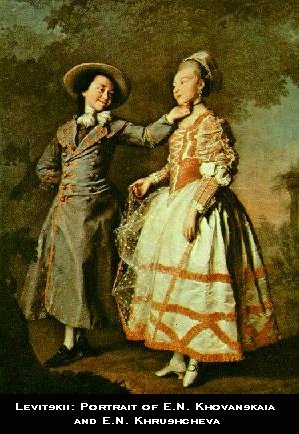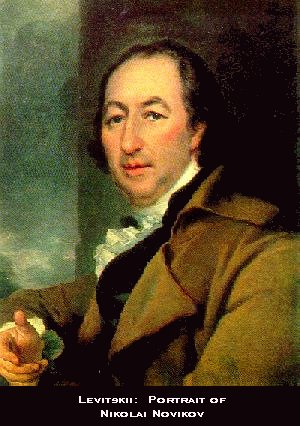

 Levitskii was born in 1735 in Kiev. His father, a priest and an experienced engraver, instilled in young Dmitrii an appreciation of art and beauty. In 1760, young Levitskii went to St. Petersburg, invited by
Antropov to assist him in the decoration of St. Andrew Cathedral. Two years later, both artists went to Moscow to work on a ceremonial portrait of Catherine II Under the Triumphal Arches, commissioned on the occasion of her coronation. At the same time, Levitskii was working on icons for the church of St. Catherine and for other churches. He did not enter the newly-opened Academy of Arts; instead, he continued to train under the watchful eye of Antropov and visited studios of European artists working in Russia. When in 1770 Levitskii was finally able to exhibit a number of his portraits, he caused an artistic sensation. Even the foreign painters were surprised by his skill and talent. Especially interesting was the Portrait of Alexander Kokorinov (1769), showing the architect of the Academy's building (and its first director). Kokorinov was portrayed standing and pointing with his hand to the plans of the building. Even though Levitskii used in the work the traditional means of formal portraiture, the brilliance of the painting and its "official" character did not make it pompous or artificial. In Kokorinov's portrait we see a man of refined tastes, whose entire life has been devoted to the creation of the institution where arts reign supreme.
Levitskii was born in 1735 in Kiev. His father, a priest and an experienced engraver, instilled in young Dmitrii an appreciation of art and beauty. In 1760, young Levitskii went to St. Petersburg, invited by
Antropov to assist him in the decoration of St. Andrew Cathedral. Two years later, both artists went to Moscow to work on a ceremonial portrait of Catherine II Under the Triumphal Arches, commissioned on the occasion of her coronation. At the same time, Levitskii was working on icons for the church of St. Catherine and for other churches. He did not enter the newly-opened Academy of Arts; instead, he continued to train under the watchful eye of Antropov and visited studios of European artists working in Russia. When in 1770 Levitskii was finally able to exhibit a number of his portraits, he caused an artistic sensation. Even the foreign painters were surprised by his skill and talent. Especially interesting was the Portrait of Alexander Kokorinov (1769), showing the architect of the Academy's building (and its first director). Kokorinov was portrayed standing and pointing with his hand to the plans of the building. Even though Levitskii used in the work the traditional means of formal portraiture, the brilliance of the painting and its "official" character did not make it pompous or artificial. In Kokorinov's portrait we see a man of refined tastes, whose entire life has been devoted to the creation of the institution where arts reign supreme.
The artist's successes continued when in 1773 he received a commission from Catherine II to paint the portraits of the students of the Smolnyi Institute who participated in theatre performances. The comission resulted in the creation of seven enchanting canvasses. The best known is the Portrait of E.N. Khovanskaia and E.N. Khrushcheva (1773), which shows the girls playing a shepherd and a shepherdess in a pastoral play. Levitskii presents them with gentle humor and does not try to give their faces the "required" neoclassical regularity, but preserves their youthful and sparkling appearance. Another famous picture from the series is the portrait of Ekaterina Nelidova (1773). In all the portraits of the Smolnyi Institute's students, Levitskii shows a wonderfully rich palette -- a symphony of shimmering silvery colors dotted with blue accents and pale pink ribbons and lace.
Even though the artist painted official portraits of the Empress and her courtiers, like the one for Catherine's coronation, his fame rests mainly on more intimate, cameral portraits of his contemporaries. He painted Ursula Mnishek, the wife of the Lithuanian Crown Marshall, pushing his "academic" technique almost to perfection by completely concealing the brush-strokes. His portrait of Anna Davia Bernuzzi, a notorious
adventuress, actress, and singer, whose behavior scandalized the capital and affected many government officials, shows a woman of a strange, almost hypnotic beauty. Her dress and various details of her toilette stand in such contrast to the ideals of neoclassical good taste and propriety that it is easy to understand why the Empress had Bernuzzi expelled from Russia. Equally remarkable are the portraits of Levitskii's family: his father and his daughter Agasha. Creating the portrait of his father, Levitskii used Rembrandt's method: everything but the face of the subject is in deep shadow; there are no details of clothing or background. Agasha is portrayed in a sarafan, a padded jacket, and a kokoshnik headdress. She is standing next to a table, empty save for a loaf of dark bread and a glass of
kvass. The girl's face is open and bright, almost luminous, and her dark eyes look straight at the viewer. The portrait of Levitskii's friend Nikolai Novikov (1797) is a good example of the master's more "personal" work. Nikolai Novikov (1744-1818) was one of the most progressive and educated men of his time, the editor of the satirical journals The Drone (Truten') and The Painter (Zhivopisets). His anti-serfdom views and his nonconformist attitude towards Catherine II and her "enlightened" reign resulted in his arrest and imprisonment in the Schluesserburg fortress (1792). He was released by Catherine's
son, Paul, in 1796. Levitskii portrayed Novikov after his release. The satirist is looking directly at the viewer. He is not a broken man, but still the same uncompromising critic of the evils of the Russian society. The light of dawn -- perhaps a symbol of enlightenment or an allusion to the newest of Novikov's ventures, the journal Morning Light -- dissipates the darkness of the night behind him. The portrait shows a thinker, a man of lofty ideals, and a confirmed believer in the unstoppable force of historical progress.
Despite his artistic success at the end of the eighteenth century, Levitskii's popularity steadily waned. He died in 1822, blind and poor. Perhaps he did not want to or could not adapt to the changes in style which affected Russian art in the first quarter of the nineteenth century. His favorite student,
Borovikovskii, made the necessary transition from neoclassicism to sentimentalism and, in a way, took his master's place; in the process, however, he had to abandon Levitskii's old-fashioned objectivity in favor of the expected and preferred
sentimental subjectivity. [A.B.] [Sources: Klimov, Zotov, Fateev, Barlamova].
